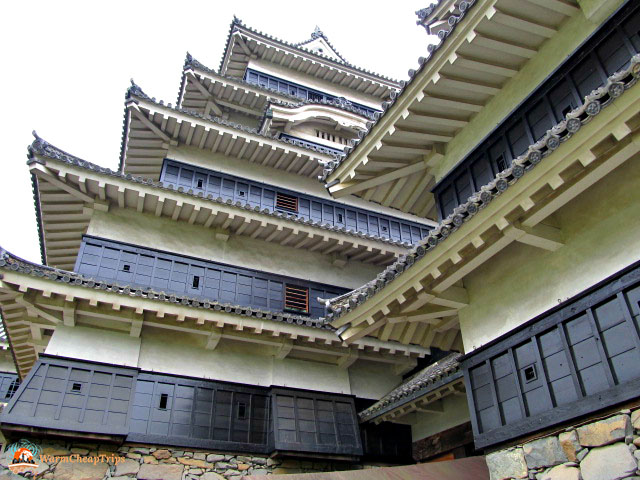Japanese Castles have an undeniable charm. Unfortunately, only a few original castles were spared from bombings, fires, and earthquakes. While reconstructed castles can still be impressive, the thrill of visiting an original Japanese castle is truly unmatched.
Among these rare original castles is Matsumoto Castle.
Matsumoto, a town nestled in the Japanese Alps, is mainly known for its stunning castle, but if you pass through, I recommend staying a few extra hours to visit Japan’s first Western-style school, explore the Art Museum featuring works by Yayoi Kusama (who was born here), and meet Gamabunta, the giant toad from the anime Naruto. Because, if you haven’t noticed, anime and Japanese films don’t make things up out of thin air—they’re full of references to real Japanese legends and traditions.
I’ve visited Matsumoto three times already, and I clearly remember my first visit. The town greeted us with a melancholic, almost surreal atmosphere on a sleepy, drizzly morning in the sweltering heat of August—a typical day for that month in Japan.
The “Crow Castle” stood gleaming against the leaden pond. Majestic and solemn in its simplicity. A black pyramid against a grey sky. Maybe it was because it was my first Japanese castle, or maybe because I knew it was an original, not a replica—but a shiver of emotion ran down my spine and stayed with me the entire day.


Matsumoto Castle
In contrast to the more famous White Castle of Himeji, Matsumoto Castle is an example of a 16th-century Japanese fortress. My visit to Matsumoto was initially a plan B, since Himeji Castle was closed for renovations that year, but I was truly impressed and that’s why I recommend including it in your Japan itinerary. I can even help you with that via a custom travel planning service.
The main keep is surrounded by a moat where the “Crow Castle” reflects with its distinctive rooftops and five-tiered black central tower (which actually contains six floors inside).
You can freely stroll around the park—perhaps with the company of local volunteer guides (they’re free and don’t accept tips!)—but to enter the castle itself, you need to purchase a ticket. Entry is in groups, and while waiting on covered benches, you can read a detailed pamphlet explaining the history and unique features of the castle.
To preserve the original wooden interiors, you must remove your shoes upon entry. However, unlike other places, since the exit is different from the entrance, you’ll need to carry your shoes with you in a provided bag.
Each floor is thoroughly explained: the first floor has openings for dropping stones on attackers, the second features arrow slits, the third is a “hidden floor,” the steep steps lead to the Daimyo’s floor, and the top floor is an attic. It’s all very fascinating, especially knowing that during the Samurai era, this castle really existed as it is today—it’s not a reconstruction!
Inside, there’s also a small display of Edo-period weapons and armor, with English descriptions.
It’s also pleasant to walk around the castle grounds. Thanks to a nearby convenience store, you can even enjoy lunch on the park benches (remember, in Japan, eating while walking is not common!). If you spend the night in Matsumoto, don’t miss the chance to see the castle lit up in the evening.
Opening Hours: 08:30–17:00
Admission: 1,200 JPY online, 1,300 JPY at the door


City Art Museum and Yayoi Kusama artworks
Unfortunately, I haven’t had the chance to visit this museum dedicated to local artists, especially the eccentric Yayoi Kusama and her iconic polka dots. From what I know, it’s absolutely worth a visit—not just for fans of modern art. It’s definitely one of the most interesting places to see in Matsumoto besides the castle.
Opening Hours: 09:00–17:00
Admission: 700 JPY online, 800 JPY at the door
Matsumoto’s Frogs
Walking from the train station to the castle, you’ll pass a shopping street called Nawate Dori, running alongside a small stream. Here you’ll find plenty of souvenir shops, antique stores, food stalls, and small restaurants—but most importantly, frogs everywhere!
Frog statues, trinkets, charms, toys, figurines, coin purses shaped like frogs (yes, just like Naruto’s!).
Frogs have become lucky symbols here. In the past, this was a pedestrian-only street where people could safely shop from the stalls (買える KAERU = “to buy”), and then return home (帰る – KAERU = “to return”). And thanks to the nearby river, real frogs (カエル-KAERU) were also common—a perfect Japanese wordplay!
Among all the statues, you’ll also find the large warrior frog statue, Gamabunta from Naruto, created by local art students.


Kaichi School
Kaichi School is the first Western-style school ever built in Japan and stands as a symbol of the early changes brought by the Meiji Restoration in the late 1800s. Built in 1876, it still preserves its original interiors. It has been turned into a museum that reconstructs school life at the time. A very interesting visit to better understand Japan’s modern historical evolution.
Opening Hours: 09:00–17:00 (Closed Mondays)
Admission: 700 JPY
How to Get to Matsumoto
There are several ways to reach Matsumoto: via Nagano, via Nagoya, or with a direct train from Shinjuku (Tokyo). I chose to pass through Nagano, where I visited Zenkoji Temple, as I wanted to make a detour to the Jigokudani Snow Monkey Park.
If you want to come to Matsumoto straight from Tokyo you can take the Azusa Express to Shinjuku for about two and a half hours.
Did you find useful this article? By me a coffee!





